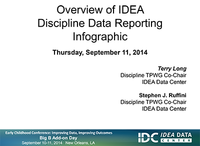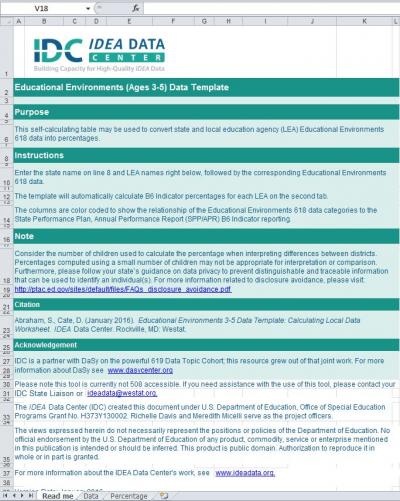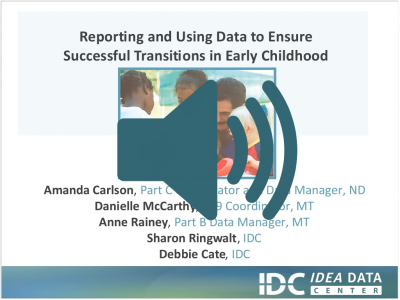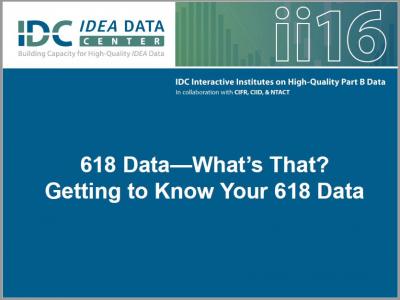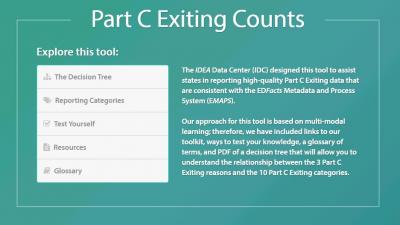Site Search
Results 1 - 7 of 9
Format: Presentations
Overview of IDEA Discipline Data Reporting InfographicThe presentation reviewed a new TA tool that summarizes the basics of reporting IDEA discipline data in the six EDFacts file formats. Presenters described and demonstrated the new IDC infographic, discussed how SEAs and LEAs can use it to improve the quality of their discipline data, and requested audience input.
Format: Reference Materials
Quick Reference Guide on Coordinated Early Intervening ServicesDeveloped by CIFR, in collaboration with IDC, this three-page quick reference guide assists states, LEAs, and stakeholders to better understand basic CEIS requirements stipulated in IDEA. The guide is updated to reflect 2016 changes in the IDEA Part B regulations on significant disproportionality. The guide describes the requirements for the provision of CEIS, the use of CEIS funds, the interaction of CEIS funds and local MOE reductions, and reporting obligations. It concludes with questions and additional resources for states to consider.
Format: Toolkits and Templates
Educational Environments 3-5 Data Template: Calculating Local Data WorksheetThis data template provides SEAs and LEAs the opportunity to see in real-time the percentages of their children ages 3-5 attending and receiving services in specific educational environments. When the LEA 618 educational environments data is simply entered on the data tab, the percentages will be calculated and displayed on the percentage tab. The use of this tool will allow SEAs to compare the percentages of children within educational environments across LEAs.
Format: Recordings
Reporting and Using Data to Ensure Successful Transitions in Early Childhood WebinarThis webinar highlighted the IDEA state reporting requirements for early childhood transitions for both Part C and Part B, found in the SPP/APR Part C Indicator 8 and Part B Indicators 11 and 12. Participants shared resources related to transition, data collection, and reporting, as well as the use of both Part C and Part B data to facilitate high quality transitions. North Dakota's Part C coordinator and data manager and Montana's 619 coordinator and data manager described how their states collect and use transition data to ensure smooth transitions for all young children as they turn three and move from early intervention services to preschool 619 services.
Format: Presentations
618 Data—What’s That? Getting to Know Your 618 DataHave you heard these terms 618, 616, EDFacts, EMAPS, file specifications, OMB-MAX, GRADS360, Data Quality Reports? Do you understand what they are referencing? Do you want to gain a higher knowledge of these terms? Participants in this presentation learned more about IDEA data reporting requirements in relation to the 618 data collections. They also learned about data quality considerations and tools states can use when going through the data collecting and reporting procedures.
Format: Online Applications
Part C Exiting CountsIDC's Part C Exiting Counts app allows users to test their knowledge of the 10 Part C Exiting categories by either starting with a child scenario and deciding which reason and category best fit the scenario or starting with a reason and category and deciding which child scenario best fits that reason and category.
Format: Toolkits and Templates
Part C IDEA Data Processes ToolkitUsing the Part C IDEA Data Processes Toolkit to document data processes for all 616 and 618 data collections will establish a well-managed process for data collection, validation, and submission. In collaboration with IDC State Liaisons, states can use the toolkit to create and maintain a culture of high-quality data and establish and support consistent practices that produce valid and reliable data, while building the capacity of state staff. The toolkit contains an overview of the toolkit, Data Collection Protocols, SPP/APR Indicator Protocols, a State Landscape Protocol, a Local EI Program Determinations Protocol, a Data Collections Calendar, and additional resources that provide a structure for documenting data processes. The Data Collection Protocols are in Word, and states can tailor them meet their states' specific documentation needs.


